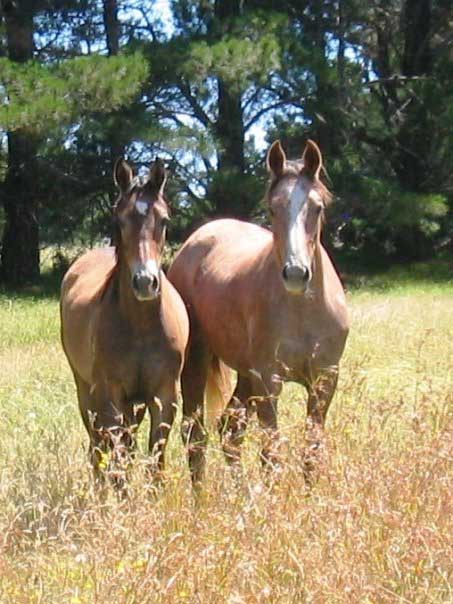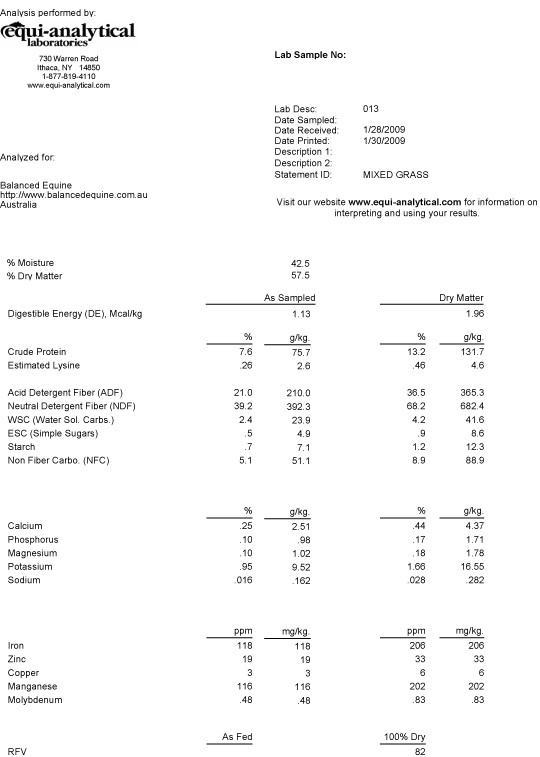Submitted by Carol Layton B.Sc M.Ed
For most people, the results for a hay or pasture test looks like a bunch of meaningless and numbers. To unlock some of the mysteries, following is an introduction to understanding what a hay or pasture test means.

A native Australian paddock made up primarily of Kangaroo Grass (Themeda sp.), which is obvious, Wallaby Grass (Danthonia sp.), Windmill Grass (Chloris sp.) and Microlena stipoides.
This is what Equi-analytical found for a representative sample of highly diverse native grasses from an Australian horse property near Canberra, ACT (the same property as the photo above).

The test has results for ‘Dry Matter’ and for ‘As Fed’. The ‘Dry Matter’ column is for calculating pasture nutrient levels and the ‘As Fed’ column is for hay. Dry matter means all the moisture has been removed but since we can weigh the amount of hay fed (not going to work with grass) the ‘As Fed’ column is particularly useful for working with hay even though it will contain a small amount of moisture
Terms Explained
% Moisture – This percentage refers to the amount of moisture in the sample when it was received by the lab. All moisture is removed for testing.
% Dry Matter – This portion of the sample contains carbohydrates, protein, fat.
Digestible Energy (DE) – Digestible energy gives the energy value of the feed, expressed as Mcal/kg. You can choose either Mcal/kg or Mcal/lb. Since the National Research Council provide nutrient requirements in grams and milligrams, it’s easier for me to work in metric. This mixed Australian native grass sample has an energy value of 1.96 Mcal/kg or 0.89 Mcal/lb. To give an idea of what this means, a 500 kg (1100 lb) horse in no work would theoretically need to consume about 8.5 kg (18.7 lb) in dry matter to maintain a good body condition score. This of course does vary depending on whether the horse has a fast or slow metabolic rate (poor doer vs good doer). A horse in heavy work such as endurance or eventing would need to consume about 14 kg (31 lb) in dry matter if no other feed was provided. If a test gives Metabolisable Energy (ME) it’s for ruminants like cattle and is not applicable for horses.
Crude Protein (CP) – Rather than protein itself this measures the level of nitrogen and nitrates. Protein contains nitrogen so it’s a useful indicator of protein, when the level of CP is considered high by a nutritionist then it’s advised to get the sample tested for nitrates as high nitrate levels can cause health issues in horses. This native pasture indicates 131.7 grams per kg. 8.5 kg contains about 1120 grams, enough protein to support a 500 kg horse up to a very heavy workload.
Estimated Lysine – Lysine is an essential amino acid which means it must come from the diet. It’s often called the limiting amino acid, if there is a lysine deficiency then the proteins that require lysine cannot be manufactured by the cells and the unused protein will be excreted, potentially causing muscle building issues. This pasture is calculated to have 4.6 grams per kg which covers the lysine requirement but not by much. A small level of supplementation would be recommended to avoid topline issues.
The fibre factions; Acid Detergent Fibre (ADF) and Neutral Detergent Fibre (NDF) are very useful for evaluating the quality of hay.
Acid Detergent Fibre (ADF) – This gives a measure of two of the complex carbohydrates that make up the cell walls lignin and cellulose. Cellulose is broken down by micro organisms (fermented) in the hind gut but lignin is virtually nonfermentable. Lignin is a key component of wood. The lower the number, the more fermentable the fibre and the easier for nutrients to be extracted from the plant material.
Neutral Detergent Fibre (NDF) – This includes lignin and cellulose but also hemicellulose, another cell wall component. The lower the ADF and the higher the difference between ADF and NDF, the more fermentable the fibre. In this example, if this pasture had been harvested for hay at the time of testing ADF is 21 and NDF 39 indicating a very nice hay for horses of all age groups. If the ADF was 39, it would mean it’s a bit tougher for horses to extract the nutrients but fine for mature horses.
WSC, ESC and starch can only be reliably tested in hay. When researchers test sugars and starch in pasture they immediately flash freeze the sample in liquid nitrogen to stop the sugars from metabolising further.
WSC (Water Soluble Carbohydrates) – These carbohydrates will dissolve to some extent in water and includes digestible sugars such as fructose, glucose, sucrose and indigestible plant sugars and some fructan.
ESC (Ethanol Soluble Carbohydrates) – ESC is a subset of WSC and includes sugars that are soluble in ethanol.
Starch – Starch is a complex carbohydrate made up of glucose sugars, it’s how plants store glucose. In animals glucose is stored as glycogen. For insulin resistant horses, glucose causes insulin to rise that may trigger the chain of steps resulting in laminitis. Dr Eleanor Kellon VMD advises to keep ESC + starch below 10% for the overall diet and individual feed ingredients.
Non Fibre Carbohydrates (NFC) – This is calculated from adding starch to WSC and soluble fibres and plant sugars other than the simple digestible sugars. It includes all the carbohydrates that are not part of the cell wall of plants.
Major minerals – Calcium, phosphorus and magnesium are needed in gram amounts in the diet compared to the trace minerals which are only needed in small amount in miligrams. Many nutritionists aim for a calcium to phosphorus ratio between 1.2:1 to 2:1 though a higher ratio is considered to be okay but a ratio of 5:1 or higher should only be temporary. Ideally, a calcium to magnesium ratio is recommended to be between 1.5:1 and 2:1. This native pasture is fine for calcium up to a heavy workload for a 500 kg horse but phosphorus is very low. Supplementation of phosphorus will also improve the calcium to phosphorus ratio. The test indicates that magnesium levels are quite generous and will support a horse up to heavy work. Some supplementation may still be required to lower the calcium to magnesium ratio.
The levels of electrolytes; potassium and sodium are included. Sodium is very low and cannot support a 500 kg horse’s needs even if the horse was in no work. Sodium and chloride can be supplemented with plain salt, best added to the horse’s feed. It’s a good idea to not just cover maintenance needs but also allow for a generous buffer for any sweat losses during the day, especially if the horse is in a hot climate and sweats easily. 2 to 4 tablespoons per day is appropriate, any excess is easily and efficiently excreted. Note the high level of potassium, it vastly exceeds a horse’s requirements but there is no reason to be alarmed, this is the norm for pasture and hay, potassium never needs supplementing unless the horse has been exercised for more than 2 hours. An electrolyte mix with potassium should be used to replace sweat losses.
Trace minerals – Smaller amounts are required but trace minerals are no less important than the major minerals, the traces include iron, copper, zinc and manganese. Many nutritionists support the ideal ratio of 1:3 for copper to zinc. In this grass sample the ratio of copper to zinc is 1:6 with both copper and zinc highly deficient for a 500 kg horse in no work and needs rise with increasing workload so both must be supplemented. Molybdenum is a trace mineral that needs to be taken into account; it can interfere with copper absorption. Both iron and manganese vastly exceed needs, both copper and zinc need to be increased to deal with these levels.
Now that we have a good idea of the nutrient levels in this example of pasture with its deficiencies and imbalances, any supplementary feeds will be chosen on the basis of how well they contribute the nutrients needed and can act as a ‘carrier’ for the mineral and salt supplementation. A nutritionist will calculate what is needed in the mineral mix and advise on other nutrients such as vitamin E and selenium supplementation, both are very important antioxidants.
Question for the Post
Do your horses have sufficient nutrients like protein, minerals and antioxidants like vitamin E and selenium to maintain a robust immune system and fuel the work you expect them to do?
Carol Layton B.Sc M.Ed, an independent equine nutritionist does feeding plans for horse owners in the USA, Australia and other countries. To learn more about mineral interactions and hay and grass testing, head to: http://www.balancedequine.com.au and check out the nutrition articles.
To learn how to put together mineral balanced diets for your horses, enrol in Dr Eleanor Kellon’s VMD NRCPlus course: http://www.drkellon.com. NRCPlus is based on the nutritional research determining minimum requirements for nutrients and the concept that the balance of nutrients is equally important because they can compete with each other for absorption.
To learn more about managing horses with insulin resistance, there is a wealth of information at http://www.ecirhorse.com along with a mailing list described on the website.




